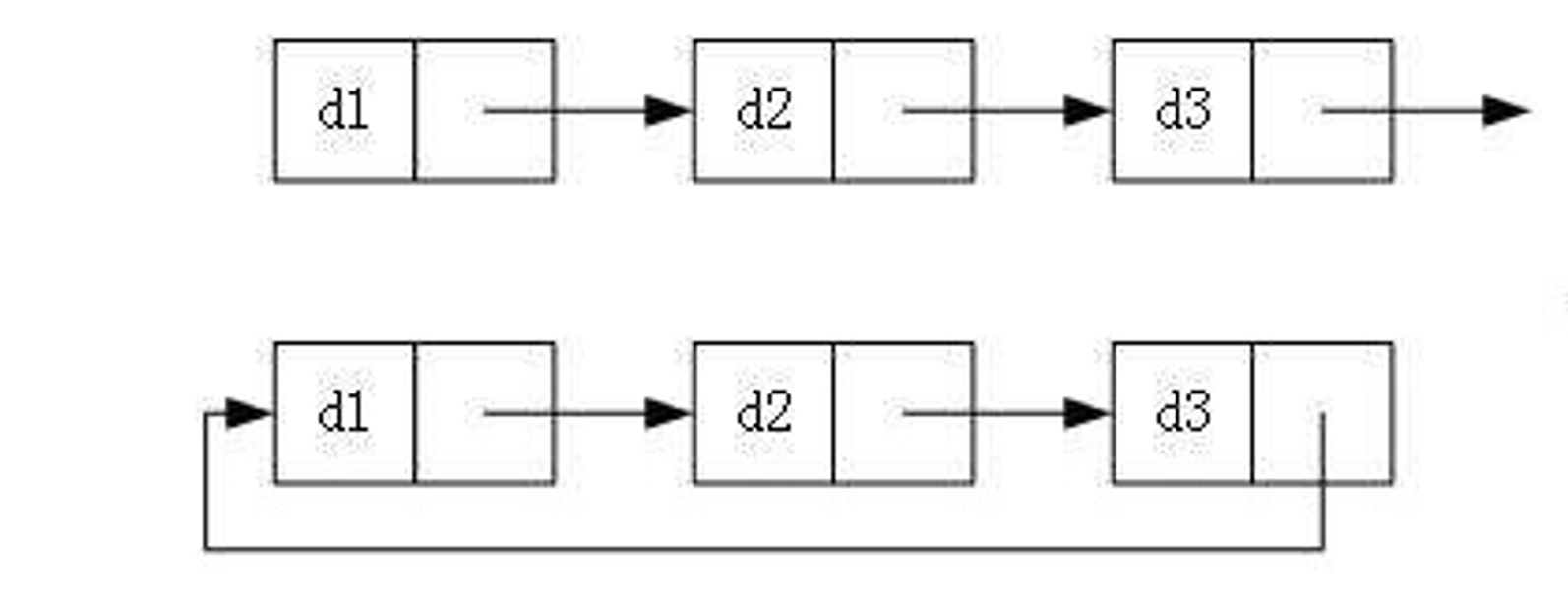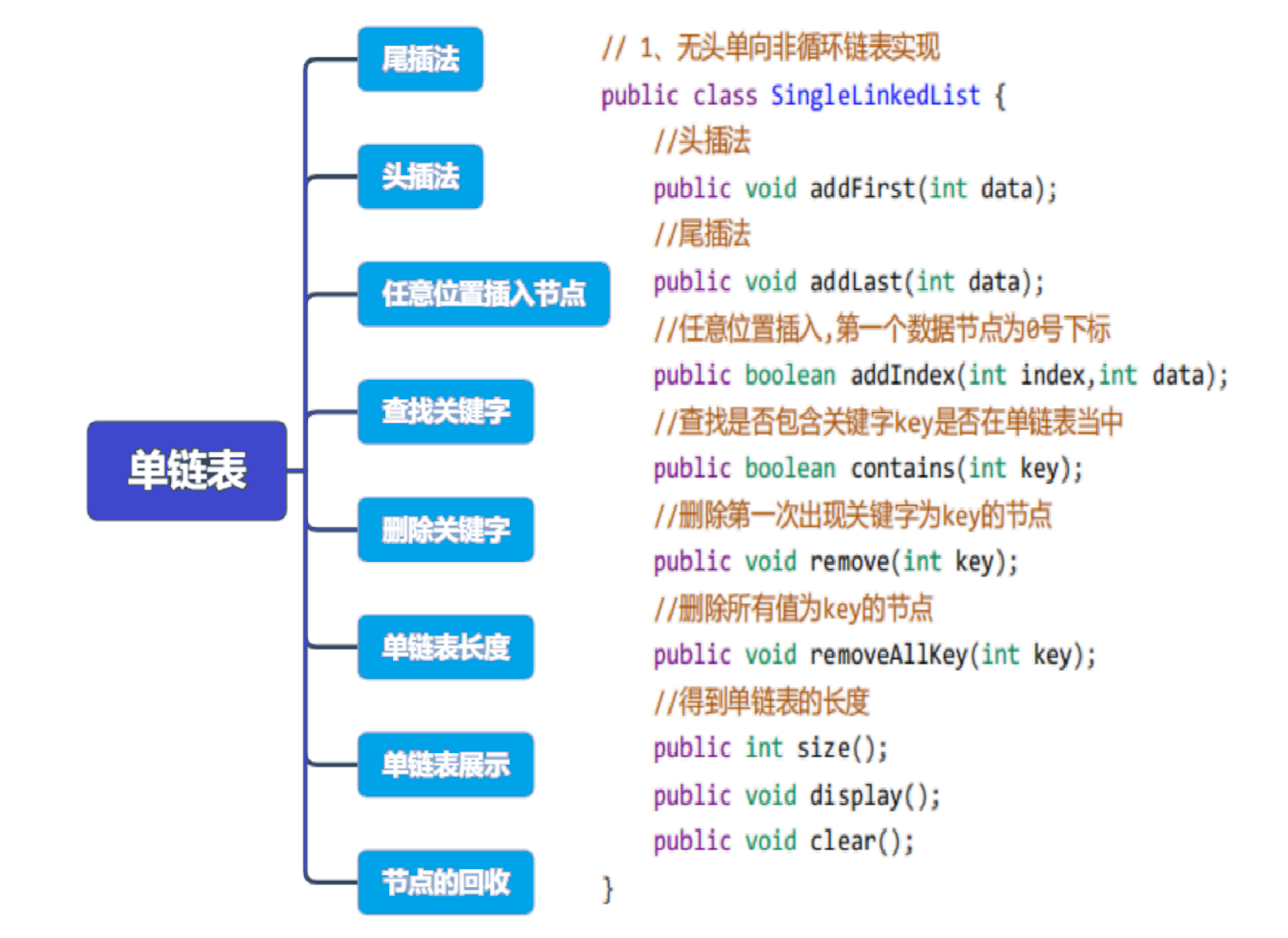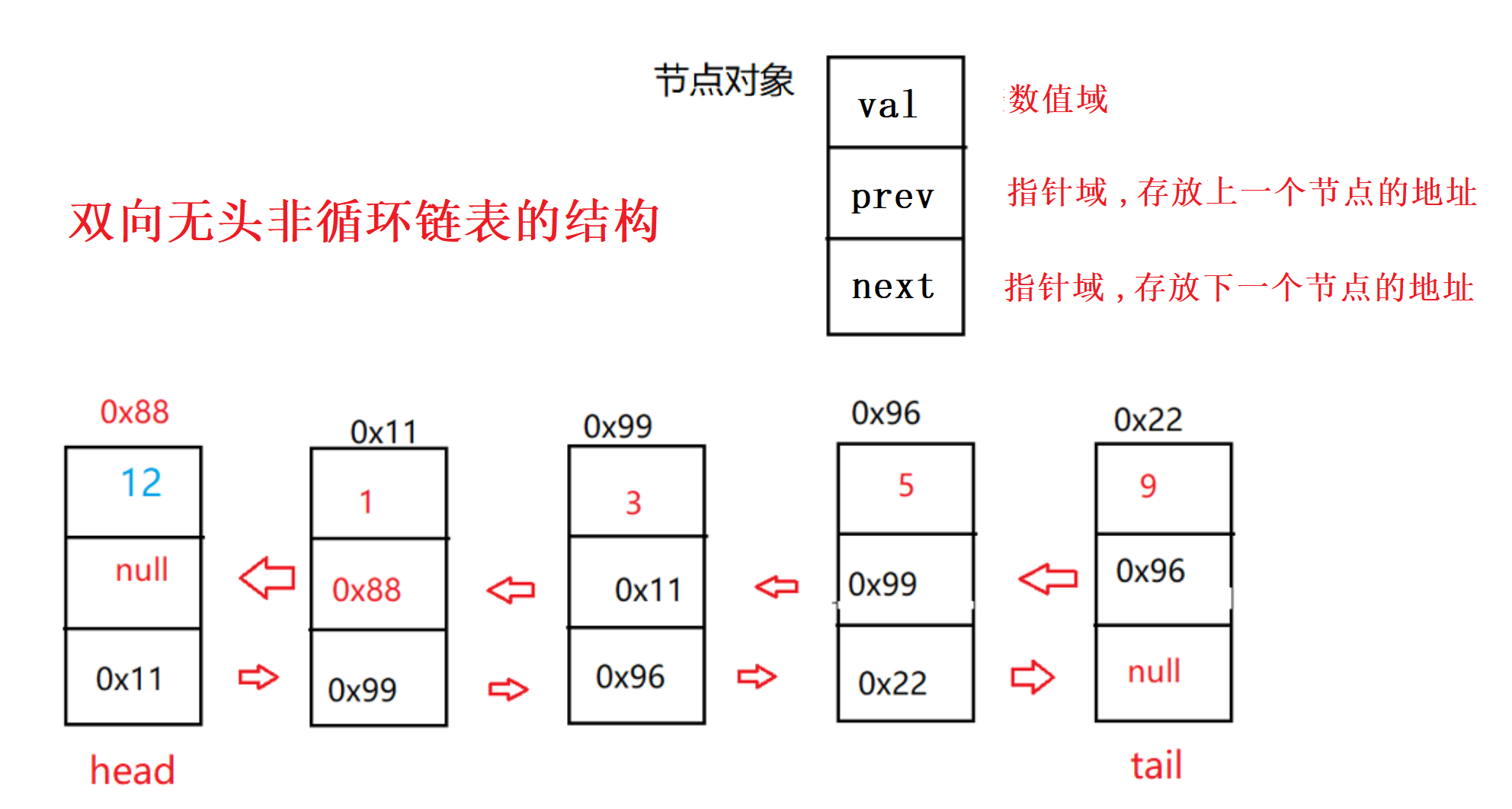6.链表篇2链表的介绍和实现(单/双链表)
文章目录
- 一. 链表的概念和分类
- 二. 无头单向非循环链表实现
-
- MySigleLinkedList.java
- IndexWrongfulException.java
- TestList.java
- 执行结果
- 注意事项
- 三. 无头双向非循环链表实现
-
- MyLinkedList.java
- IndexWrongfulException.java
- TestList.java
- 执行结果
- 注意事项
一. 链表的概念和分类
链表是一种物理存储结构上非连续存储结构,数据元素的逻辑顺序是通过链表中的引用链接次序实现的 。
 实际中链表的结构非常多样,以下情况组合起来就有8种链表结构:
实际中链表的结构非常多样,以下情况组合起来就有8种链表结构:
- 单向或者双向

- 带头或者不带头

- 循环或者非循环

这里列出这8种链表结构
- 不带头单向不循环链表
- 不带头单向循环链表
- 不带头双向不循环链表
- 不带头双向循环链表
- 带头单向不循环链表
- 带头单向循环链表
- 带头双向不循环链表
- 带头双向循环链表
这里对于带头和不带头要注意区分一下 , 带头链表中链表的头节点是固定不变的且头节点的数值域是虚拟的 (无效的 , 不存放数据) , 不管数据在哪里插入和删除 , 头节点都不会变化 ; 而不带头链表 , 链表的第一个节点 (头节点) 是有效节点 , 数值域是有效的 , 如果在不带头链表中进行头插或者删除第一个节点 , 头节点会发生变化 .
本篇博客重点介绍下面两种链表 , 使用Java语言去实现 :
- 无头单向非循环链表:
结构简单,一般不会单独用来存数据 ; 实际中更多是作为其他数据结构的子结构,如 哈希桶、图的邻接表等等。
- 无头双向不循环链表 :
在Java的集合框架库中LinkedList底层实现就是无头双向循环链表。
二. 无头单向非循环链表实现
下图所示为无头单向非循环链表的结构


MySigleLinkedList.java
public class MySigleLinkedList {
//内部类实现节点
static class ListNode {
public int val;//存放元素
public ListNode next;//记录下一个节点的引用
public ListNode(int val) {
this.val = val;
}
}
public ListNode head;//记录头节点的引用
//打印链表里面的数据,默认从头开始打印
public void display() {
ListNode cur = this.head;
//条件不能是cur.next,否则最后一个节点无法打印
while(cur != null) {
System.out.print(cur.val+" ");
cur = cur.next;
}
System.out.println();
}
//获取单链表的长度
public int size() {
int count = 0;
ListNode cur = this.head;
while (cur != null) {
count++;
cur = cur.next;
}
return count;
}
//查找某个数据key是否在单链表中
public boolean contains(int key) {
ListNode cur = this.head;
while(cur != null) {
if(cur.val == key) {
return true;
}
cur = cur.next;
}
return false;
}
//头插法
public void addFirst(int data) {
ListNode node = new ListNode(data);
node.next = this.head;
this.head = node;
}
//尾插法
public void addLast(int data) {
ListNode node = new ListNode(data);
ListNode cur = this.head;
if(cur == null) {
this.head = node;
}else {
//找到最后一个节点
while (cur.next != null) {
cur = cur.next;
}
cur.next = node;
}
}
//在任意位置插入,第一个数据节点为0号下标
public void addIndex(int index, int data) throws IndexWrongfulException{
if(index < 0 || index > size()) {
throw new IndexWrongfulException("index位置不合法!");
}
if(index == 0) {
addFirst(data);
return;
}
if(index == size()) {
addLast(data);
return;
}
//先走index-1步,找到要插入位置的前一个位置
ListNode cur = findIndexSubOne(index);
ListNode node = new ListNode(data);
//插入,修改指向
node.next = cur.next;
cur.next = node;
}
private ListNode findIndexSubOne(int index) {
ListNode cur = this.head;
while(index-1 != 0) {
cur = cur.next;
index--;
}
return cur;
}
//删除第一次出现数据key的节点
public void remove(int key) {
if(this.head == null) {
return;
}
//判断头节点
if(this.head.val == key) {
this.head = this.head.next;
return;
}
//先找到key位置的上一个位置
ListNode cur = findPrevOfKey(key);
if(cur == null) {
System.out.println("不存在你要删除的元素"+key);
return;
}
//删除
cur.next = cur.next.next;
}
private ListNode findPrevOfKey(int key) {
ListNode cur = this.head;
while(cur.next != null) {
if(cur.next.val == key) {
return cur;
}
cur = cur.next;
}
return null;
}
//删除所有值为key的节点
public void removeAllKey(int key) {
if(this.head == null) {
return;
}
//从第二个节点开始判断
ListNode cur = this.head.next;
ListNode prev = this.head;//记录要判断节点的上一个节点
while(cur != null) {
if(cur.val == key) {
//删除
prev.next = cur.next;
cur = cur.next;
}else {
prev = cur;
cur = cur.next;
}
//最后判断头节点
if(this.head.val == key) {
this.head = this.head.next;
}
}
}
/*public ListNode removeElements(int val) {
if(head == null) {
return null;
}
//从第二个元素开始判断
ListNode cur = this.head;
while(cur.next != null) {
if(cur.next.val == val) {
cur.next = cur.next.next;
}else {
cur = cur.next;
}
}
//最后判断头节点
if(this.head.val == val) {
this.head = this.head.next;
}
return this.head;
}*/
//清空单链表
public void clear() {
this.head = null;
}
}
IndexWrongfulException.java
public class IndexWrongfulException extends RuntimeException{
public IndexWrongfulException() {
}
public IndexWrongfulException(String message) {
super(message);
}
}
TestList.java
public class TestList {
public static void main(String[] args) {
MySigleLinkedList linkedList = new MySigleLinkedList();
System.out.println("头插测试");
linkedList.addFirst(1);
linkedList.addFirst(2);
linkedList.display();
System.out.println("尾插测试");
linkedList.addLast(3);
linkedList.addLast(2);
linkedList.addLast(1);
linkedList.addLast(4);
linkedList.display();
System.out.println("任意位置插入");
try {
linkedList.addIndex(2,666);
linkedList.addIndex(8,666);
} catch(IndexWrongfulException e) {
e.printStackTrace();
}
linkedList.display();
System.out.println("单链表中有"+linkedList.size()+"个数据");
System.out.println("看单链表中是否包含某个数据");
System.out.println(linkedList.contains(666));
System.out.println("删除第一个指定数据");
linkedList.remove(1);
linkedList.remove(9);
linkedList.display();
System.out.println("删除全部的指定数据");
linkedList.removeAllKey(2);
linkedList.display();
System.out.println("清空单链表后再添加一个数据");
linkedList.clear();
linkedList.addFirst(888);
linkedList.display();
}
}
注意事项
- 在代码中需要进行遍历链表时 , 要注意区分 cur != null 和 cur.next != null 的使用 , 虽然二者都可以去遍历链表 , 但cur != null , 最后一次循环判断使cur指向为null ; 而cur.next != null 的最后一次循环判断使cur指向的是链表的最后一个节点 .
- 单链表中插入和删除数据 , 需要先找到要处理位置的上一个位置 , 然后再进行指针指向的修改 .
- Java当中没有指针的概念 , 这里的节点通过类来实现 , 创建一个引用类型变量 , 这个引用就是Java当中的 “指针” 了 .
- 单链表中实现清空单链表只需要置空头节点即可 , 要与双链表中的清空区分
三. 无头双向非循环链表实现
给出结构图


MyLinkedList.java
public class MyLinkedList {
//内部类定义节点
static class ListNode {
public int val;
public ListNode next;//记录下一个节点
public ListNode prev;//记录前一个节点
public ListNode(int val) {
this.val = val;
}
}
public ListNode head;//指向头节点
public ListNode tail;//指向尾巴节点
//打印链表
public void display() {
ListNode cur = this.head;
while(cur != null) {
System.out.print(cur.val+" ");
cur = cur.next;
}
System.out.println();
}
//获取链表中元素的个数
public int size() {
ListNode cur = this.head;
int count = 0;
while(cur != null) {
count++;
cur = cur.next;
}
return count;
}
//判断数据在链表中是否存在
public boolean contains(int key) {
ListNode cur = this.head;
while(cur != null) {
if(cur.val == key) {
return true;
}
cur = cur.next;
}
return false;
}
//头插法
public void addFirst(int data) {
ListNode node = new ListNode(data);
if(this.head == null) {
this.head = node;
this.tail = node;
return;
}
node.next = this.head;
this.head.prev = node;
this.head = node;
}
//尾插法
public void addLast(int data) {
ListNode node = new ListNode(data);
if(this.head == null) {
this.head = node;
this.tail = node;
return;
}
this.tail.next = node;
node.prev = this.tail;
this.tail = node;
}
//在任意位置插入, 认为头节点为0位置
public void addIndex(int index, int data) {
if(index < 0 || index > this.size()) {
throw new IndexWrongfulException("index位置不合法");
}
if(index == 0) {
this.addFirst(data);
return;
}
if(index == size()) {
this.addLast(data);
return;
}
ListNode node = new ListNode(data);
ListNode cur = findIndexListNode(index);
node.next = cur;
node.prev = cur.prev;
cur.prev.next = node;
cur.prev = node;
}
public ListNode findIndexListNode(int index) {
ListNode cur = this.head;
while(index != 0) {
cur = cur.next;
index--;
}
return cur;
}
//删除第一个出现的指定元素
public void remove(int key) {
ListNode cur = this.head;
while(cur != null) {
if(cur.val == key) {
//如果要删除的是头节点
if(this.head == cur) {
this.head = this.head.next;
//如果链表中只有一个节点
if(this.head != null){
this.head.prev = null;
}
}else{
cur.prev.next = cur.next;
if(cur.next != null) {
cur.next.prev = cur.prev;
}else {//如果要删除的是尾巴节点
this.tail = cur.prev;
}
}
return;
}
cur = cur.next;
}
}
//删除全部的指定元素
public void removeAll(int key) {
ListNode cur = this.head;
while(cur != null) {
if(cur.val == key) {
//如果要删除的是头节点
if(this.head == cur) {
this.head = this.head.next;
//如果链表中只有一个节点
if(this.head != null){
this.head.prev = null;
}
}else{
cur.prev.next = cur.next;
if(cur.next != null) {
cur.next.prev = cur.prev;
}else {//如果要删除的是尾巴节点
this.tail = cur.prev;
}
}
}
cur = cur.next;
}
}
//清空
public void clear() {
ListNode cur =this.head;
while(cur != null) {
cur.prev = null;
cur.next = null;
cur = cur.next;
}
this.head = null;
this.tail = null;
}
}
IndexWrongfulException.java
public class IndexWrongfulException extends RuntimeException{
public IndexWrongfulException() {
}
public IndexWrongfulException(String message) {
super(message);
}
}
TestList.java
public class TestList {
public static void main(String[] args) {
MyLinkedList list = new MyLinkedList();
System.out.println("头插测试");
list.addFirst(1);
list.addFirst(2);
list.addFirst(3);
list.display();
System.out.println("尾插测试");
list.addLast(4);
list.addLast(5);
list.addLast(6);
list.display();
System.out.println("获取链表中元素的个数");
System.out.println(list.size());
System.out.println("判断数据在链表中是否存在");
System.out.println(list.contains(4));
System.out.println(list.contains(8));
System.out.println("在任意位置插入");
list.addIndex(0, 666);
list.addIndex(3, 666);
list.addIndex(list.size(), 666);
list.display();
System.out.println("删除第一个出现的指定元素");
list.remove(4);
list.display();
System.out.println("删除全部的指定元素");
list.removeAll(666);
list.display();
System.out.println("清空链表后再添加一个元素");
list.clear();
list.addFirst(888);
list.display();
}
}
注意事项
- 与单链表中的插入和删除实现进行区分 , 这里双链表中的插入和删除 , 因为此时链表是双向的 , 所以不需要像单链表一样找要处理位置的前一个位置 , 只需要找到要处理的位置去改变前驱和后记指针指向即可 .
- 在进行删除元素操作时 , 需要考虑的细节比较多 , 特别需要注意删除头节点与尾节点时的操作(考虑prev为null和next为null , 与删除中间节点不同) , 具体实现看上面给出的代码 .
- 注意双链表的清空链表实现 , 与单链表中的进行区分 , 双链表中需要手动去将每个节点的两个指针域置为null , 最后再将head和tail去置空 .
参考文章:数据结构:单链表——带头结点与不带头结点步骤详解
